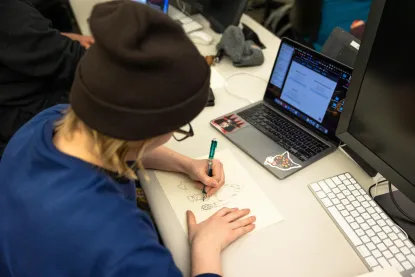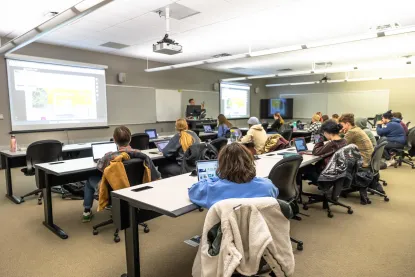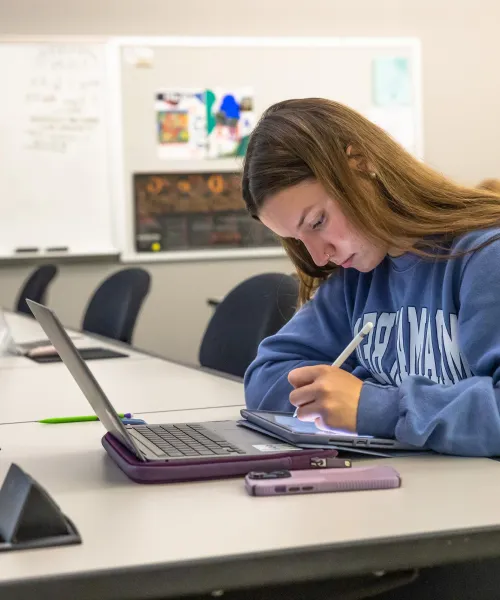Quick Links

About the Program
Formerly known as Computer Art, Electronic Art & Animation at NMU provides a broad range of skills in digital media, including 2D and 3D animation, digital modeling and sculpting, and motion design. Courses combine software instruction, design fundamentals, motion principles, concept development, business practices, and problem-solving, with a focus on developing adaptability for a constantly evolving industry.
The program primarily supports other Art & Design emphases, allowing students to enhance their primary focus. For example, students with an emphasis in Illustration may take Digital Sculpting to provide other methods of creating character designs; students with an emphasis in graphic design may take Motion Design to provide a basis for creating motion graphics for broadcast, trailers, and social media.
Students receive an Apple MacBook and access to industry-standard software, including Adobe Creative Suite, Maxon Cinema4D, ZBrush, and Substance Painter. Facilities include Apple workstations, 4K video production, access to digital cameras, lighting studios, a greenscreen stage, drawing tablets, scanners, and a variety of printers, including large-format and archival inkjet printers.
Electronic Art & Animation Faculty
Electronic Art & Animation Courses
ARTD 225 Electronic Art & Animation: Foundations
4 credit hours
Offered: Fall, Winter
Introduction to the concepts and practices of electronic art and animation. Topics vary and are based upon technology developments and professional practices in the field of electronic art and animation. (Topics may include 3D modeling, digital sculpting, 2D/3D animation, basic scripting, introductory game development, 3D printing, analog to digital workflows, augmented reality, and/or AI.)
AD 334A Digital Sculpting and Modeling
4 credit hours
Offered: Winter, even-numbered years
Prerequisite: AD 101 or ARTD 225 or instructor’s permission.
Practical overview of the theory and practice of 3D digital sculpting and modeling with consideration to concept art, game/animation characters, illustration, scenic props, sculpture, collectible toys, and 3D printed objects. Commercial applications of digital sculpting and modeling will be explored in tandem with concepts focusing on form, design, and articulation.
AD 334B Motion Design
4 credit hours
Offered: Fall
Prerequisite: AD 101 or ARTD 225 or instructor permission.
Practical overview of the fundamentals of motion graphics and animation with consideration to broadcast, cinema, web, app, and multimedia applications. Creative and commercial approaches to motion design will be explored while developing conceptual skills, aesthetic awareness, and pre-professional production workflow practices.

Electronic Art & Animation Studio
Electronic Art & Animation students use the shared Art & Design Computer Studio, which includes four labs, two for laptops and two equipped with Apple computers, large flat-screen displays, Wacom drawing tablets, and scanners. Students have access to industry-standard software such as Adobe Creative Suite, Maxon Cinema4D, ZBrush, Substance Painter, Final Cut Pro, and more.
The studio also provides a wide range of production equipment for student use, including digital cameras, video cameras, tripods, panoramic tripod heads, 360 cameras, lighting equipment, and microphones, many of which are available for overnight checkout. Printing options include a large-format inkjet printer, mid-sized pre-press inkjet printers, and color laser printing.
Electronic Art & Animation FAQ
What degree should I pursue?
Electronic Art & Animation is not a dedicated emphasis in the School of Art & Design. Students wishing to pursue studies in Electronic Art & Animation support that interest with related media to support Electronic Art & Animation, such as Digital Cinema, Illustration, and Graphic Design. Most Electronic Art & Animation students pursue the Bachelor of Fine Arts (BFA) degree, which includes more studio credit hours than the BA or BS options. The Bachelor of Arts (BA) or Bachelor of Science (BS) degrees allow students to combine their major with a minor or studies in another field.
Will I need to submit a portfolio for admission?
If you are accepted to the university, you may pursue a degree within the School of Art & Design. A portfolio review is not required for admission.
For information on general University admission requirements, contact the Admissions Office.
What will I study in Electronic Art & Animation?
The Electronic Art & Animation program focuses on 2D animation, some 3D animation, and 3D modeling/sculpting. The courses serve largely to support other emphasis areas within the School of Art & Design while providing a sub-emphasis, of sorts. The primary software used in the curriculum is Maxon Cinema 4D, ZBrush, Adobe Photoshop, and Adobe After Effects.
What equipment is required for Electronic Art & Animation?
As a student at NMU, you will be issued a laptop computer, and as an Art and Design major, the laptop will be an Apple MacBook. The laptop will come with the majority of the required software already loaded. There are four computer labs available for student use as well. The labs are used for instruction, and in some cases, when specific software is unavailable for the laptops, projects must be completed in the labs. Additionally, digital cameras and digital video cameras are available in specific classes for student use.
Do most of your majors find employment?
The majority of students who continue to pursue work in Electronic Art & Animation find employment in the media publishing industry – both broadcast and streaming formats. Multimedia design (such as motion graphics and AR/VR) is one of the fastest growing fields within art and design. Graduates are currently working throughout the United States from Oregon to Rhode Island. The opportunity for internships in Marquette, MI are limited, so students are encouraged to use summer as an opportunity to research companies and even complete internships which increase their chances of employment upon graduation.
